The Health Education Assets Library (HEAL) is a collection of over 22,000 freely available digital materials for health sciences education. The collection is now housed at the University of Utah J. Willard Marriott Digital Library.
Filters: Collection:"ehsl_heal"
| Title | Description | Subject | Collection | ||
|---|---|---|---|---|---|
| 51 |  | Heparan sulfates in the terminal sac period of the lung (mouse, fetus) | Stain: fluorescence microscopy with anti-heparan sulphate antibody (a phage-display antibody, HS4E4). Heparan sulfates are linear polysaccharides that belong to the group of the glycosaminoglycans (GAGs). These GAGs are found associated with basement membranes as shown here. The sulphated saccharide... | Bronchioli; Air spaces; Terminal sac period | Poja Histology Collection - Respiratory System Subset |
| 52 | 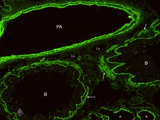 | Heparan sulfates in the terminal sac-period of the lung (mouse, fetus) | Stain: fluorescence microscopy with anti-heparan sulphate antibody (a phage-display antibody, LKiv69). Heparan sulfates are linear polysaccharides that belongs to the group of the glycosaminoglycans (GAGs). The sulphated saccharide domains provide numerous docking sites for protein ligands. These GA... | Bronchioli; Air spaces; Terminal sac period | Poja Histology Collection - Respiratory System Subset |
| 53 | 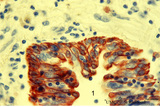 | Keratin 7 in the bronchial epithelium of the lung (human, adult) | Stain: anti-keratin 7 antibody (Pan-Ck 7) immunoperoxidase staining (with aminoethylcarbazole (AEC) substrate). The epithelium of the bronchus (1) stains dark brown-red after the reaction with AEC indicating a positive reaction for cytokeratin 7. This antibody can be used in the study of development... | Bronchiolus; Immunoperoxidase; Immuno-reaction | Poja Histology Collection - Respiratory System Subset |
| 54 | 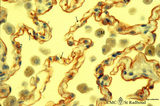 | Keratin 7 in the lining alveolar epithelium of the lung (human, adult) | Stain: anti-keratin 7 antibody (Pan-Ck 7) immunoperoxidase staining (with aminoethylcarbazole (AEC) substrate). Both alveolar epithelial cell types I (1) and II (2) stain dark brown-red after the reaction with AEC indicating a positive reaction for cytokeratin 7. Note the white (non-stained) capilla... | Pneumocyte I; Pneumocyte II; Imunoperoxidase; Immuno-reaction | Poja Histology Collection - Respiratory System Subset |
| 55 |  | Keratin 7 staining in dysplastic epithelium of a bronchus (human, adult) | Stain: anti-keratin 7 antibody (Pan-Ck 7) immunoperoxidase staining (with aminoethylcarbazole (AEC) substrate). A red-brown staining with AEC indicates a positive reaction for cytokeratin 7. Disturbances in the growth and maturing might result in dysplasia of the epithelium with a changed reaction p... | Immunoperoxidase; Immuno-reaction | Poja Histology Collection - Respiratory System Subset |
| 56 |  | Keratin 7 staining in squamous metaplasia and dysplasia of the epithelium of a bronchus (human, adult) | Stain: anti-keratin 7 antibody (Pan-Ck 7) immunoperoxidase staining (with aminoethylcarbazole (AEC) substrate). A red-brown staining with AEC indicates a positive reaction for cytokeratin 7. Note that the top layer only reacts weakly positive for keratin 7 (↓). Upon squamous metaplasia the bronch... | Squamous metaplasia; Immunoperoxidase; Immuno-reaction | Poja Histology Collection - Respiratory System Subset |
| 57 | 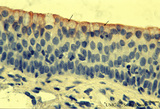 | Keratin 7 staining in squamous metaplasia of the epithelium of a bronchiolus (human, adult) | Stain: anti-keratin 7 antibody (Pan-Ck 7) immunoperoxidase staining (with aminoethylcarbazole (AEC) substrate). A red-brown staining with AEC indicates a positive reaction for cytokeratin 7. Note that the top layer only is stained positively for keratin 7 (↓). Upon squamous metaplasia the bronchio... | Bronchiolus; Squamous metaplasia; Immunoperoxidase; Immuno-reaction | Poja Histology Collection - Respiratory System Subset |
| 58 | 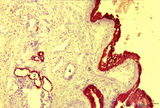 | Keratin staining of bronchus epithelium (human, adult) | Stain: Anti-keratin-5-7-14-19 (OVTL 12/5 monoclonal antibody with immunoperoxidase staining on frozen sections). The pseudostratified epithelium (1) is stained keratin-positively (brown product) as well as the epithelial derivates such as the bronchial glands (2) and their excretory ducts (3). Other... | Bronchial epithelium; Keratin antibodies; Tumor diagnosis | Poja Histology Collection - Respiratory System Subset |
| 59 |  | Keratin staining of bronchus epithelium (human, adult) | Stain: Anti-keratin-5-7-14-19 (OVTL 12/5 monoclonal antibody with immunoperoxidase staining on frozen sedctions). The pseudostratified epithelium (1) reacts positively (brown-red product), the nuclei of the basal cells are well visible (arrows). Other structures react negatively (blue stain) such as... | Tumor diagnosis; Bronchial epithelium; Lung parenchym; Keratin antibodies | Poja Histology Collection - Respiratory System Subset |
| 60 |  | Lamellar body of a type II alveolar cell in the lung (dog) | Electron microscopy. Extrusion of surfactant material out of a type II alveolar cell (pneumocyte II, great alveolar cell). After fusion of a multilamellar body (1) (cytosome) with the apical cell membrane (note microvilli 2) the electron-dense lamellar content or surfactant (consisting of phosphatid... | Type II alveolar cell; Pneumocyte II; Multilamellar bodies; Cytosomes; Tubular myelin | Poja Histology Collection - Respiratory System Subset |
| 61 | 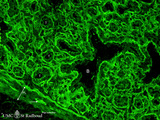 | Laminin in the canalicular period of the lung (mouse, embryo) | Stain: Fluorescence microscopy with anti-laminin antibody. Laminin is a component of the basement membrane. Strong fluorescence visualizes the course of all basement membranes, especially around the bronchioles (B) and their branches in the developing lung tissue. In between the distal air spaces (t... | Bronchioli; Canalicular period | Poja Histology Collection - Respiratory System Subset |
| 62 | 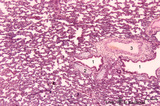 | Late terminal sac period of developing lung (human, fetus, low magnification) | Stain: Hematoxylin and eosin. Cross-sections of a bronchus (1) with cartilage rings (2) closely associated with pulmonary arteries (3). The alveolar appearance is evident, and the open spaces represent future alveolar duct systems as well as alveolar sacs. The cellular septa are still thick due to n... | Lung development; Terminal sac period | Poja Histology Collection - Respiratory System Subset |
| 63 |  | Longitudinal section of trachea (human, adult) | Stain: Azan. On top: the epithelium (1) is pseudostratified with cilia and goblet cells. The dense lamina propria (2, ↓, deep blue) is demarcated from the submucosa with seromucous tracheal glands (3). C-shaped cartilage rings (C, light blue) maintain patency. The cartilage edges are connected by ... | Pseudostratified epithelium ; Seromucous glands; Tracheal glands; Fibroelastic membrane ; Adventitia | Poja Histology Collection - Respiratory System Subset |
| 64 |  | Longitudinal section of trachea (human, adult) | Stain: Azan. On top: the epithelium (1) is pseudostratified with cilia and goblet cells on a distinct basement membrane (↓). There is almost no demarcation (at this magnification) between lamina propria and submucosa due to the dense blue (2) staining of elastic fibers reinforced by collagen fiber... | Pseudostratified epithelium ; Tracheal glands; Fibroelastic membrane | Poja Histology Collection - Respiratory System Subset |
| 65 |  | Lung alveoli (human) | Stain: Azan. Alveoli (diameter about 200 m) are formed by thin walls of epithelial cells (1) such as type I alveolar cells and (blue stained) fine collagen (3) and elastin intermingled with dilated capillaries (2). | Poja Histology Collection - Respiratory System Subset | |
| 66 | 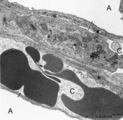 | Lung capillaries and air-blood barrier (rat) | Electron microscopy. Two neighboring capillaries (C) and the alveolar spaces (A). The endothelial cell (1) of the upper capillary contains an organelle-rich cytoplasm, a centriole (2), contractile filaments (↓) and electron-dense membrane-bound granules, the so-called Weibel-Palade bodies. These b... | Poja Histology Collection - Respiratory System Subset | |
| 67 | 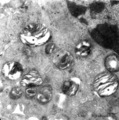 | Multilamellar bodies of type II alveolar cell in the lung (mouse) | Electron microscopy. The cytoplasm of the type II alveolar cell (pneumocyte II) contains characteristic electron-dense multilamellar bodies (*) in different maturing stages. The lamellar bodies are responsible for the vacuolated appearance of these cells, and they give rise to surfactant (phospholip... | Pneumocyte II; Multilamellar bodies; Type II alveolar cell | Poja Histology Collection - Respiratory System Subset |
| 68 | 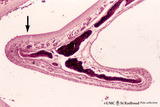 | Nasal concha (dog, isolated turbinate bone) | Stain: Hematoxylin and eosin. This concha (turbinate with red-black-stained bone (1), is covered by a thin respiratory mucosa (3) and by a thick olfactory mucosa (2, arrow). Within the respiratory epithelium light stained goblet cells are visible between the low columnar/cuboidal epithelial cells (c... | Conchae nasales; Olfactory epithelium; Respiratory epithelium | Poja Histology Collection - Respiratory System Subset |
| 69 |  | Nasal concha with respiratory mucosa (dog, high magnification) | Stain: Hematoxylin and eosin. (↑) Indicates the transition of the olfactory epithelium (1) into the respiratory epithelium (2) with pseudostratified ciliated epithelium and goblet cells. The submucosa is richly vascularized (3). Lamellar bone of the turbinate (4) is stained reddish-black. | Conchae nasales; Olfactory epithelium; Respiratory epithelium | Poja Histology Collection - Respiratory System Subset |
| 70 | 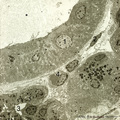 | Nasal glands of the nasal vestibulum (rat) | Electron microscopy. At the top part of a striated draining duct with a wide lumen (*); these cuboidal ductal cells (1) contain many basolaterally located mitochondria. The ductal cells are enforced by interstitial fibroblast (2) and a capillary (4). Neighboring serous gland cells (5) contain dark s... | Nasal vestibulum; Seromucous glands; Nasal glands; Serous cells; Secretion granules; Intercalated duct; Striated duct | Poja Histology Collection - Respiratory System Subset |
| 71 | 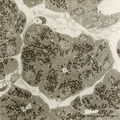 | Nasal glands of the nasal vestibulum (rat) | Electron microscopy. A low-power magnification reveals serous acini of a seromucous gland; in the center and lower left corner lumina (*) of the acini are present and dense secretion granules of varying sizes represent the active cells. Between the acini the distended interstitium reveals a fibrobla... | Nasal vestibulum; Seromucous glands; Nasal glands; Serous cells; Secretion granules | Poja Histology Collection - Respiratory System Subset |
| 72 | 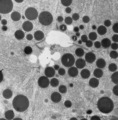 | Nasal glands of the nasal vestibulum (rat, higher magnification) | Electron microscopy. Part of a serous acinus of a seromucous nasal gland demonstrates the central lumen (*) formed by four gland cells. Note junctional complexes (↑) and the close proximity of the dense secretion granules (2) ready to be released into the central lumen. These active cells contain ... | Nasal vestibulum; Seromucous glands; Nasal glands; Serous cells; Secretion granules | Poja Histology Collection - Respiratory System Subset |
| 73 |  | Neuroepithelial body in terminal bronchiolus (golden hamster) | Electron microscopy. Three epithelial cells, as part of the N(euro) E(pithelial) B(ody), contribute to a cluster of neuroendocrine cells. They belong to the Amine Precursor Uptake and Decarboxylation cell system so-called APUD cells. The dense-core granules (↓) contain among others dopamine or ser... | Terminal bronchiolus ; Neuro-endocrine cells | Poja Histology Collection - Respiratory System Subset |
| 74 |  | Nostril area of nasal vestibulum - cutaneous region - human | Stain: Azan. Slightly keratinized squamous epithelium (1) with thin red cornified layer; (2) hair follicles; (3) vibrissae and (4) associated sebaceous glands. At the bottom skeletal muscle fibers; (5) transverse part of the musculous nasalis; (6) connective tissue. | Poja Histology Collection - Respiratory System Subset | |
| 75 |  | Olfactory epithelium in the nasal cavity (mammals) | Three-dimensional scheme electron microscopy. Six olfactory cells (1) surround one massive central supporting cell (2). A third, basal cell (3) is located at the basal plate aposing to the supporting cell. These olfactory cells are tall and slender bipolar nerve cells with chemoreceptive functions. ... | Pseudostratified epithelium; Olfactory epithelium; Basal cells; Olfactory vesicle; Bipolar neuron | Poja Histology Collection - Respiratory System Subset |
